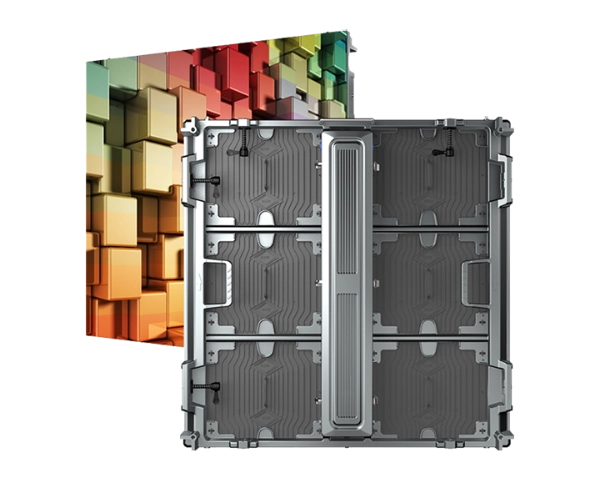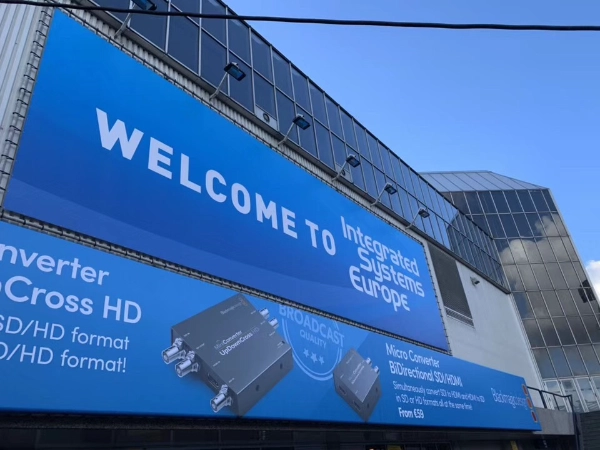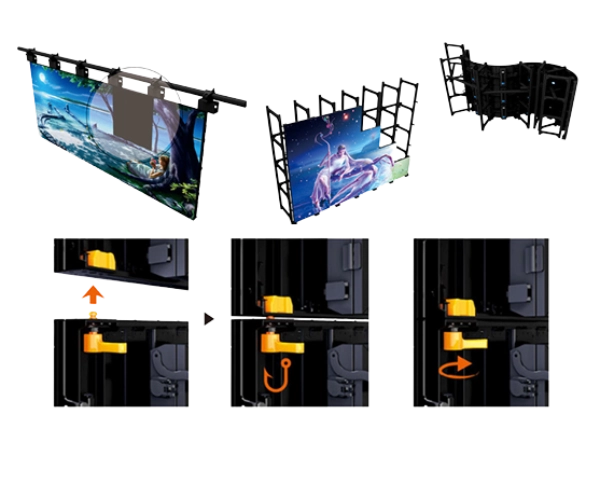Did you know that outdoor LED display screens can increase engagement by up to 47%? These vibrant screens are revolutionizing advertising and event promotion.
learn more
 Article source:GALED
Article source:GALED
 Oct 26, 2023
Oct 26, 2023
 View : 310
View : 310
Welcome to the world of captivating advertising display screens! In today's fast-paced digital age, businesses are constantly seeking innovative ways to grab their audience's attention and leave a lasting impression. Gone are the days of static billboards and traditional print ads; now, it's all about dynamic, interactive displays that captivate audiences like never before.
With advertising display screens, you have the power to showcase your brand in an eye-catching and immersive way. From bustling city streets to shopping malls and even inside elevators, these high-tech screens can be found virtually everywhere, ready to enthrall passersby with their vivid imagery and compelling content.
But what exactly are advertising display screens? How can they benefit your business? And most importantly, how can you create content that truly engages your target audience? Fear not – we've got all the answers for you right here in this comprehensive guide. So buckle up as we dive into the fascinating world of advertising display screens and unleash their incredible potential!

When it comes to advertising, the possibilities are endless. And with the advancement in technology, traditional billboards and posters are no longer the only options available. Enter advertising display screens, a dynamic and eye-catching way to capture your audience's attention.
There are several types of advertising display screens that you can choose from depending on your needs and budget. LED screens, for instance, offer vibrant and high-resolution displays that can be seen even in broad daylight. These screens are commonly used in outdoor settings such as stadiums or busy shopping districts.
LCD screens, on the other hand, provide clear visuals and can be used both indoors and outdoors. They come in various sizes and shapes, making them suitable for different locations like retail stores or airports.
Another type is OLED screens which produce stunning visuals with deep contrast levels and true blacks. They have flexible panels which allow for unique installations like curved displays or even wearable advertisements.
There are interactive touchscreens that engage viewers by allowing them to interact directly with the content displayed. These touch-enabled screens are often used in malls or museums where users can browse through products or access additional information about exhibits.
No matter what type of advertising display screen you choose, one thing is certain - they have revolutionized the way brands communicate their messages to audiences. With their versatility and captivating visual capabilities, these screens create impactful experiences that leave a lasting impression on viewers.
So whether you're looking to promote a new product launch or simply want to increase brand awareness, consider incorporating an advertising display screen into your marketing strategy. It's an investment worth considering as it enables you to stand out from competitors while engaging with potential customers on a whole new level!
Advertising display screens have revolutionized the way businesses connect with their target audiences. These dynamic and eye-catching screens offer a multitude of benefits that traditional advertising methods simply can't match.
Advertising display screens are highly versatile. They can be strategically placed in various locations, such as shopping malls, airports, or even on public transportation. This allows businesses to reach a wider audience and increase brand visibility.
Moreover, these digital screens offer a more engaging and interactive experience for viewers. With vibrant colors and captivating visuals, they grab attention instantly and leave a lasting impression on potential customers. Additionally, advertising display screens often incorporate multimedia elements like videos or animations to further enhance the viewer's experience.
Another significant benefit is the ability to easily update content in real-time. Unlike traditional static billboards or print ads, advertising display screens allow businesses to change their messaging quickly and effortlessly. This flexibility enables companies to keep up with current trends or promotions without having to invest in new physical materials each time.
Furthermore, advertisers using display screens can gather valuable data about consumer behavior through built-in analytics tools. By analyzing metrics such as impressions or engagement rates, businesses gain insights into which content resonates most effectively with their target audience. This data-driven approach helps optimize future ad campaigns for better results.
Investing in advertising display screens provides long-term cost savings compared to other forms of marketing communication. While there may be an initial investment upfront for hardware installation and content creation, ongoing costs are significantly reduced since updates can be made digitally rather than printing new materials repeatedly.

Creating effective content for advertising display screens is essential to captivate audiences and drive meaningful engagement. Here are some key strategies to consider when crafting your content:
1. Know Your Audience: Understanding your target audience is crucial for creating content that resonates with them. Conduct research to uncover their preferences, interests, and demographics.
2. Compelling Visuals: Utilize eye-catching visuals that grab attention and convey your message effectively. High-quality images, videos, animations, or infographics can make a lasting impact on viewers.
3. Clear Message: Keep your messaging concise and straightforward. Use strong headlines and taglines that communicate the core benefits of your product or service in a memorable way.
4. Call-to-Action: Incorporate a clear call-to-action (CTA) in your content to encourage viewers to take the desired action – whether it's making a purchase, visiting a website, or subscribing to a newsletter.
5. Dynamic Content: Consider using dynamic elements such as changing images or real-time data updates to keep the content fresh and engaging over time.
6. Contextual Relevance: Tailor your content to align with the location or context where it will be displayed. This could involve incorporating local references or customized messages based on specific events or seasons.
7. Personalization: Leverage data insights to personalize the content based on individual viewer preferences whenever possible, enhancing relevance and increasing engagement.
By following these guidelines, you can create compelling content that grabs attention on advertising display screens while effectively conveying your brand message!
As technology continues to evolve at a rapid pace, so does the world of advertising. And one area that is poised for major growth in the coming years is advertising display screens.
One exciting development on the horizon is the integration of artificial intelligence (AI) into advertising displays. Imagine walking down a busy street and seeing an advertisement that adjusts its content based on your personal preferences or even your current mood. With AI-powered displays, advertisers will be able to deliver highly targeted and personalized messages to their audiences, resulting in greater engagement and conversion rates.
Another trend that we can expect to see in the future is an increase in interactive display screens. Gone are the days of static advertisements; instead, consumers will be able to interact with ads by touching, swiping, or even speaking to them. This level of interactivity not only captures attention but also provides valuable data for marketers about consumer behavior and preferences.
Moreover, advancements in display screen technology itself will play a role in shaping the future of advertising. We can anticipate thinner screens with higher resolutions, enabling advertisers to create stunning visuals that truly captivate audiences. Additionally, flexible and curved screens will become more prevalent, allowing for unique advertising placements and immersive experiences.
Furthermore, as our society becomes increasingly connected through smart devices and IoT (Internet of Things), we can expect advertising display screens to seamlessly integrate with other technologies. For instance, imagine receiving personalized offers directly on your smartphone after passing by an advertisement screen or having ads displayed on wearable devices such as smartwatches.
In conclusion, the future holds vast possibilities for advertising display screens. From AI-powered personalization to interactive experiences and advanced technological capabilities, these innovative tools are set to revolutionize how brands engage with their target audience.
Stay tuned as this exciting evolution unfolds!

Advertising display screens have revolutionized the way businesses connect with their target audiences. These dynamic and captivating screens offer a range of benefits that traditional advertising methods simply cannot match.
From digital billboards to interactive kiosks, there are various types of advertising display screens available for businesses to choose from. Each type offers unique features and advantages, allowing companies to tailor their messaging to specific locations and demographics.
One of the greatest strengths of advertising display screens is their ability to grab attention and engage viewers. With vibrant visuals, eye-catching animations, and interactive elements, these screens can captivate audiences like never before. By creating compelling content that resonates with viewers, businesses can leave a lasting impression and drive customer action.
To create effective content for advertising display screens, it's important to consider factors such as audience demographics, location context, and desired outcomes. By understanding who your target audience is and what they find valuable or interesting, you can craft messages that are relevant and impactful.
The future looks promising for advertising display screens. As technology continues to advance at a rapid pace, we can expect even more innovative features in the years to come. From augmented reality experiences to personalized advertisements based on real-time data analysis, the possibilities are endless.